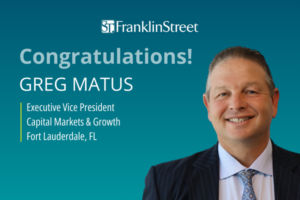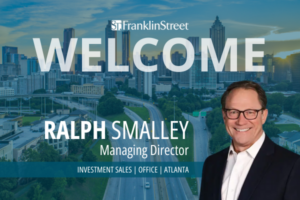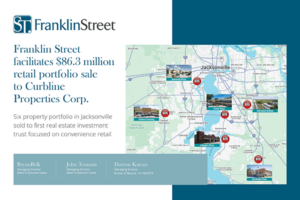The market for multi-family properties as investments remains strong and vigorously trending up with more investors competing for increasingly scant deals, say brokers who help clients navigate buying, selling and financing such real estate.
Demand for rentals is high right now, given how challenging it remains for a number of people to buy a home or condo in South Florida, said Deme Mekras, regional managing partner for Franklin Street Real Estate Services.
“Investor demand is extremely healthy with more demand than supply,” he said. “This is an extremely durable form of investment: people always need housing, and if an investor has manageable or no debt, there’s the flexibility of moving rents up or down without the pressure of making mortgage payments.”
Moreover, multi-housing investment is one of the easiest products to understand, Mr. Mekras said.
“It’s less complicated to qualify a tenant for an apartment than for a shopping center,” he said. “Tenants are easily replaced, unlike a commercial venture where you can lose one third of your occupancy if a large tenant moves out.”
The market remains healthy because there’s more supply than demand, Mr. Mekras said.
“Prices have risen dramatically in the past six months or so, and while investors are bullish, they are not sure if rent increases will continue, he said. “They are placing more emphasis on current rental income rather than what it will be in the future.”
Markets fluctuate because you have the dynamic between underlying value and the perception of value, said Carlos Fausto Miranda, broker and president of Fausto Commercial Realty.
“Generally the market trends slowly, but changes can come quickly and you have to be alert to the,” he said. “I’m bullish on this market, but I say so cautiously and in the realization that things can change quickly.
The important thing is to buy intelligently so you can weather a downturn when it comes, but stay flexible, open and aggressive to opportunities. Ultimately, market fluctuations translate to opportunities for those with the knowledge, discipline and cool head to view them.”
Mr. Miranda said the multi-housing market has been defined by strengthening of trends that started in earlier quarters.
“We haven’t seen any big shifts, but rather a consolidation of earlier patterns, all very indicative of the mid stages of a growth cycle,” he said. “There will be some very interesting changes coming though. Those include macroeconomic issues such as rising interest rates, which exert upward pressure on cap rates, often come coupled with inflation and better economic output, which buoy other aspects of properties, loosening credit standards, which would permit more players to enter the market and more creative deal structures, as well as more specific operating issues like rising insurance rates and concerns of rising water levels.”
Mr. Miranda said the rates of return investors are willing to tolerate vary widely. “For mid-level multi-family, required rates are probably averaging just below 6%, but that figure on a per-property basis may be misleading, because not everyone is underwriting properties in the same way and making the same assumptions.”
Cap rates ultimately are a series of assumptions that combine current cash flow, expected future appreciation and perceived risk, Mr. Miranda said. “Six percent may be an average, but those figures can vary dramatically based on area, property details, and investor intentions.”
He said he believes more buyers are entering the marketplace for several reasons: the weakness of alternative investments, the generally positive outlook for the general and local economy, external incentives such as international capital flight, and a general bullishness that Miami as a city is evolving to take on a grander international role.
“The underlying assets are showing great health as well, principally because the rental market is strongly skewed in the landlord’s favor,” Mr. Miranda said. “We’re dealing with a perfect recipe for strong rent growth and tenant stability, in other words better quantity and better quality of cash flow.”
He said vacancy rates in most markets are hovering about 2%, well below equilibrium.
“This is exacerbated especially in the urban core by rapidly growing demographics; in other words more people moving in, and of better economic means,” Mr. Miranda said. “Middle and lower income categories are not seeing any significant supply growth from new construction, because the cost of building makes it near prohibitive. This means that as demand intensifies in an already tight rental market, there is no release valve for that pressure except for rents to continue growing aggressively.”
Student housing as investment is a relatively new market over the past few years, said Dan Carlo, principal of the Miami office for Avision Young. He said the factors that attract investors include the “boomlet” of the age group either entering or just graduating from college and the expanding rate of matriculation into colleges and universities.
Furthermore, most schools in Miami don’t have enough housing for their students and building more dorms is a lower priority than educational facilities such as labs, Mr. Carlo said.
“Florida International University (FIU), the second-largest university in the state, has plus or minus 53,000 students and student housing is about 4,500 beds, which means less than 10% of the student body is living on campus,” he said.
Lifestyle trends among young people are also contributing to the popularity of investing in student housing.
“Students today are much more desirous of modern, highly amenitied housing facilities and they’re willing to pay for it,” Mr. Carlo said.
He pointed as an example to 109TOWER at 737 SW 109th Ave., just outside FIU, which opened during the summer. A local developer was approached by multiple investors before the facility was competed, he said. Educational Realty Trust (ERT) which looks at student housing all over the country, bough the facility, which includes a pool, fitness club and movie theater as well as the two- and four-bedroom fully furnished apartments.
ERT is one of several publicly-traded real estate investment trusts that solely foucs on student housing, Mr. Carlo said. The others are Campus Crest Communities and American Campus Community.
Another factor contributing to the popularity of student housing as an investment is that Miami’s colleges and universities are actively seeking out-of-state and international students, he said. “Those who end up coming here for school obviously can’t live with family so need an apartment.”
The robust demand for this type of housing, Mr. Carlo predicted, will continue for the foreseeable future. View PDF



